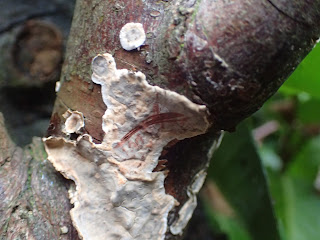27th January 2018
It was my birthday in the week, so on Saturday Cathy & I decided to visit the Brecks for a walk and lunch. It was a lovely sunny day - haha, of course it wasn't, it was gloomy and cloudy like all of the other times I've been out so far this year. As we left Norwich it began to drizzle, and it then rained constantly for the rest of the time we were out.
Our main destination was an area of woodland where I hoped to see a new species of earthstar. Earlier in the year I had been discussing earthstars with Mark Joy, who has spent the last couple of years visiting a large variety of sites to find and photograph these interesting fungi. During this conversation it emerged that he had seen one of the species I'd not come across whilst in Norfolk last autumn. With most fungi they would have decomposed long before now, but earthstars often just dry up, which means that the fruiting bodies can be found almost all year round in some places.
Having parked up we entered the woods, and following Mark's directions I soon found the right area. To my delight the earthstars were still present, some completely dried up but others at least holding their form. These were Crowned Earthstars (Geastrum coronatum), growing beneath a cypress tree. They were all concentrated around the base of one tree, but as Cathy checked other trees nearby she found five fresher looking earthstars. These turned out to be Striate Earthstars (Geastrum striatum), a commoner species but nice to see. It is something of a feature that many earthstars have similar habitat requirements, so if you find one species then it is quite likely you'll find another there too. Cathy also found some Pearly Powdercaps (Cystoderma carcharias), which I'd not seen before.
Crowned Earthstar
Crowned Earthstar
Striate Earthstar - note the clear stalk and collar to the spore sac, and the clearly grooved peristome (opening at the top)
Pearly Powdercaps
Next we moved on to Lynford Arboretum. In a short loop we admired the drifts of Snowdrops flowering below the trees, before moving to the gate to watch the feeders. Coal Tits and Marsh Tits joined the commoner species, whilst the sight of a Treecreeper on the ground was unusual. I noticed a hellebore growing beside the path so went over to check for leaf mines (now a well engrained habit!) and instead noticed some concentric circles, indicating a fungal leaf spot. At home I was able to identify this as Hellebore Black-spot (Microsphaeropsis hellebori). This might be well known to gardeners, but Tony Leech confirmed that there is only one previous Norfolk record, from Ted Ellis in 1956!
From Lynford we headed to Brandon Country Park. We both like the cafe here, however on this occasion we arrived just too late for hot food, so we contented ourselves with a toasted tea cake and an apple crumble tart. From the cafe window we could see lots of birds on the feeders, including more Coal Tits. Whilst in the cafe 'Weather with you' by Crowded House came on whilst the rain continued outside. Sometimes its hard not to think that there is a cosmic joker out there...






















